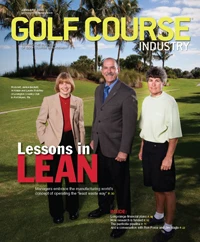“He’s not a member, grandma. He’s a caddy.” Ah, yes … the whiny voice of the pubescent Spaulding Smails character in the movie Caddyshack. It brings a smile to the many golf/comedy enthusiasts who are familiar with the movie.
Spaulding reminds me that, during the next few years, there might be fewer places in America for the bratty rich kids to speak so eloquently of nonmembers and guests who play golf at private country clubs. That’s because 10 to 15 percent of private clubs – equating to about 500 facilities – are in danger of extinction, according to the National Golf Foundation. An increasing number of private clubs are dealing with declining membership – 13 percent on average, according to NGF – and allowing outside play from nonmembers.
Furthermore, among at-risk clubs – defined as those reporting financial difficulties – the average membership decline is 29 percent, and 57 percent of them say they’re operating at a loss, according to NGF. Reasons for declining membership include the financial downturn, job relocation, a desire for course variety, and work and family obligations. Private clubs are responding to membership decline by offering special membership arrangements, making capital improvements (if they have access to enough capital), expanding health-conscious offerings and targeting women and children.
But even implementing those revenue-generating ideas isn’t going to save all the financially troubled private clubs. A more drastic change will take place for some: going public. But this is nothing new. It’s been happening for years. Conversions have outnumbered closures 10 to one during the past 10 years, according to NGF. Between 1999 and 2008, 387 private clubs converted to public facilities, and 39 closed. However, it’s likely the number of conversions will increase significantly during the next several years, propelled by the sagging economy and the need for a broader customer base. There will be closures, but the numbers won’t be as significant as conversions.
To put the private club market into perspective, there are about 4,400 private golf clubs in America – about the same number as there was in 1929 – that support an estimated 2.1 million golfers, according to NGF. The number of private clubs peaked at 4,898 in 1998.
So, will the private golf club at which you work become public in the near future? Has it been discussed? Is it unsettling to some? To you? A number of clubs won’t be able to keep their doors closed to the public much longer. But it’s not necessarily a bad thing for the industry as long as those facilities remain golf oriented and meet demand for rounds, lessons, apparel, etc.
It’s more likely the older, more storied clubs (many with old money) will remain private, and the newer clubs that a lack distinct history or reputation – and obviously financial stability and planning – will be the ones to convert to public facilities.
Conversions could be a double-edged sword for superintendents. They probably won’t have as easy a time maintaining a public course compared to a private one because of the increase of the number of tee times and outings and the variety of golfers. However, they’ll probably have fewer headaches caused by those power-wielding members nagging them about every little detail on the course. Instead, it’ll be all about the bottom line. Salaries could fluctuate, too, and budgets will be managed even tighter. All considered, they’re different problems resulting in the same headaches.
Superintendents facing pending conversions should use their network to talk to peers who’ve been in similar situations. After learning more about the transition, some superintendents might decide to spruce up their resume and seek a job change.
When the private-to-public conversion happens at vulnerable facilities, superintendents will have to adapt and manage the operation differently. Be prepared for that. Also recognize you may be better off as a result of public money’s potential, albeit with fewer laughs caused by the Spaulding Smails of the world.
As for club members, they won’t have to worry about the Al Czerviks of the world razing their beloved courses to build condos, office buildings or homes. They just might be booking tees times with the Danny Noonans and Tony D’Annunzios of the world. It might be that or shelling out a lot more dough to join the upper echelon of exclusive private clubs.

Explore the January 2009 Issue
Check out more from this issue and find your next story to read.
Latest from Golf Course Industry
- From the publisher’s pen: Conscientious of a bigger role
- Bernhard and Company partners with Laguna Golf Phuket
- Terre Blanche showcases environmental stewardship
- VIDEO: Introducing our December issue
- Bernhard and Company introduces Soil Scout
- Nu-Pipe donates to GCSAA Foundation’s Centennial Campaign
- GCSAA enhances golf course BMP tool
- Melrose leadership programs sending 18 to 2026 GCSAA Conference and Trade Show





